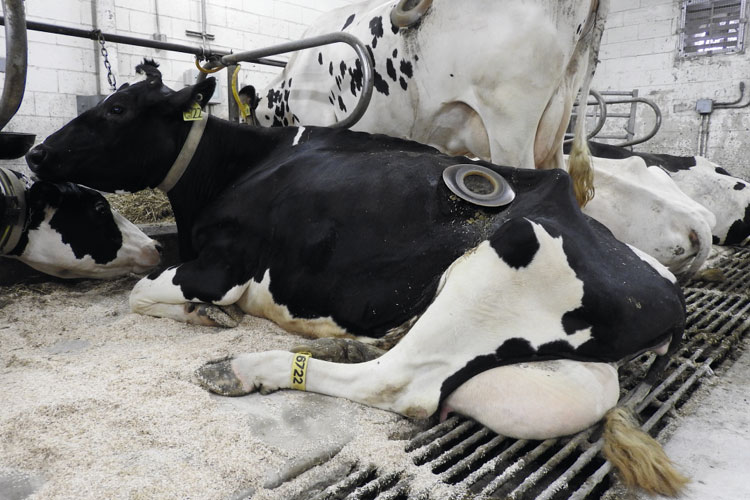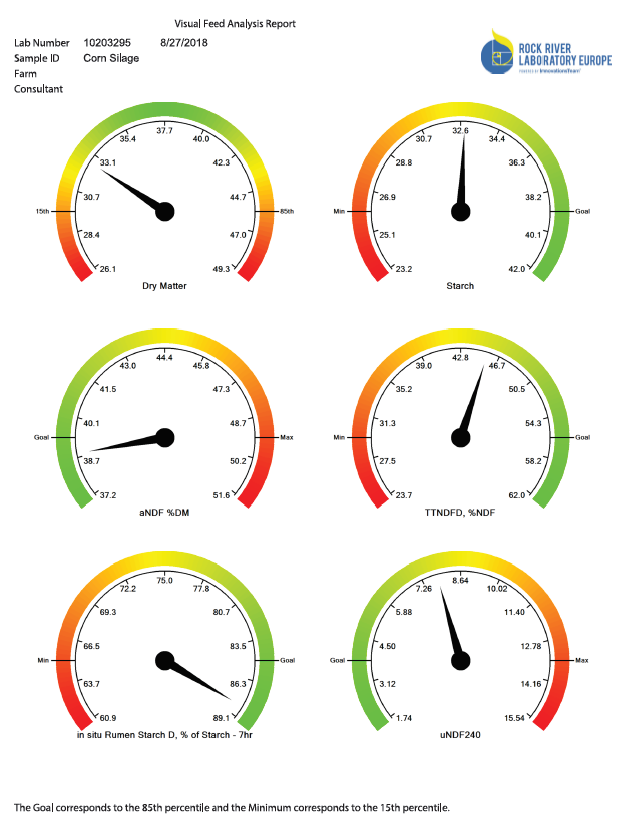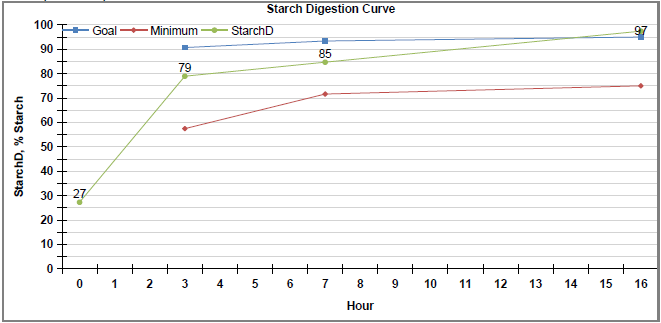Modern values - with lots of power for feeding in practice
The analysis and evaluation of the results is detailed and comprehensive. Rock River Laboratory Europe provides many new and innovative values for practice. This gives farmers and consultants a good tool for ration optimization and performance prediction. Some of them are described as follows:
NDF digestibility
NDF is essential, but at the same time limiting nutrient for the cow. It promotes animal health on one hand, but limits its potential performance by lower energy concentration/kg compared to other main nutrients. To reduce the limitation of NDF, its proportion in the basic feed should be as low as possible, while the digestibility of the NDF should be as high as possible. In order to determine the essential part of the fiber, a sufficient level uNDF240 (undigested part of the fiber) has to be ensured. The amount depends both on the lactation stage of the cow and on the cow’s weight. The proportion of the fiber is represented by the aNDFom value, and the digestibility by NDFD (in 24h, 30h, 48h, 120h, & 240h increments). To calculate the optimum levels, the values are fed into a ration-calculation program based on the CNCPS model which calculates the ration. In order for the feeding consultant and the farmer to estimate the potential of the basic feed in advance, the TTNDFD and the dynamic NDF values are given.
In addition, the digestion curve of the crude fiber is compared with the other silages tested. 1 kg additional digestible fiber in the rumen allows the cow to produce 3.5 kg more milk.
In situ starch digestibility
When evaluating starch as a nutrient it is important to understand not only the starch content, but more so, it’s availability to the cow and her microbes. It is worth taking a closer look on the starch degradation and the exact determination over time. The in situ method is modern and precise, and also available via NIR.
Traditionally, ruminal starch digestibility was determined in vitro, meaning “in the glass” and, outside of a biological system, became a widespread method. However, Powell Smith et al. (2015) and Schuling et al. (2016) showed in two independent experiments, that there is no connection between the results of in vitro measured starch digestibility and the actual degradation of starch in the cow. Much more accurate is the determination of starch degradation in the rumen via the in situ method. In situ means “on the spot”. Samples are placed in semipermeable bags are put into cows, directly into rumen fluid and its microbes and microorganisms. After the defined times – 0 hours, 3 hours, 7 hours and 16 hours – the remaining starch is measured in the sample material and the rate of degradation (kd) is determined.
Schuling et al. (2016) has proven that this approach to measure ruminal starch digestibility in the cows is very precise.
ROCK RIVER LABORATORY in Wisconsin has a close cooperation with the University of Wisconsin in Madison and access to large numbers of experimental cows. These in situ-determined values form the basis of the NIR calibration that is also used by ROCK RIVER LABORATORY EUROPE. This is the most accurate and fastest analysis option for starch degradation in corn silages, ear corn, high moisture corn, corn grain and TMRs.
ROCK RIVER LABORATORY is the only laboratory that uses the in situ starch method via NIR to determine the degradation of starch in the rumen. This is the fast and reliable method to get a better understanding of the potential of a feed. Starch digestibility has a large influence on the performance of the animal: 1 kg additional digestible starch in the rumen allows the cow to produce 3,5 kg more milk.

Dryed Forage sample


Practical relevance
2. Analysis to determine carbohydrate digestibility in the rumen (degradable fiber, starch, sugar, pectins, etc.) and thus predict the production of volatile fatty acids and proteins from the cow.
3. Analysis of the nitrogen fractions of the feed to describe the supply of nitrogen to the rumen microorganisms in conjunction with the carbohydrate fractions. Requirement to maximize the protein synthesis of the cow and to ensure the small intestine supply of the cow. The more precisely the potential of homegrown feeds can be determined, the more likely to avoid costly and harmful supply for animals. Avoiding over-supply not only saves costs in feedstuffs, but also saves the environment through reduced ammonia or phosphate loads.

Composition of fiber in TMRs
Dynamic Feed Evaluation

Prof. Mike Van Amburgh from Cornell University is a major contributor to the development of CNCPS. Prof. Mike Van Amburgh of Cornell University is crucial to the development Of CNCPS.
American universities have accumulated international research of fiber and starch digestion and their influence on the performance of ruminants. The dynamic calculation systems developed for this purpose, such as the CNCPS (Cornell Net Carbohydrate and Protein System), also help to clarify the processes of rumen digestion. CNCPS has been continuously developed since the early 1990s. Originally intended for research into ruminant nutrition, it has developed into a strong program for the exact prediction of the nutritional needs, and also the formulation of animal rations. Countless research over the past 25 years, as well as the description of the rumen function and metabolism form the basis of today’s CNCPS. CNCPS is widely used and licensed through commercial ration-balancing programs like AMTS or NDS.
The basis is always the adjustment with living cows or in vivo values. For example, the calculation of demand for lysine and methionine, the ruminal N-supply, and the milkquantity prognosis is based on 389 experiments on 15 farms with 50 different rations (J.Dairy Sci. 98: 6361 ff). The post-ruminal N supply and possible milk output are made possible by BLUP model calculations. CNCPS allows the calculation of the first limiting nutrient in the ration.
The „Dynamic CNCPS“ analysis package from Rock River Laboratory Europe provides all the parameters that the current CNCPS needs to calculate the rations for a herd. It is the most sophisticated analysis which helps evaluate the best. It has the 3h, 120h and 240h digestibility of NDF, and the in situ starch kd in forages and feeds. DYNAMIC CNCPS also reports the true amino acid, lysine, methionine, and histidine content with this test. It also provides TTNDFD (Total Tract Neutral Detergent Fiber Digestibility) exclusively.

In situ cows of the University in Madison / Wisconsin. They check the prediction models on a regular basis in her rumen. This creates a more accurate picture of the nutrients and their potential in the cow.

What value feed actually has “know” the up to 200 different Microorganism species in the rumen of the cow accurate. They represent the by far most accurate feed analysis and provide information for further formulation of the CNCPS model.
Variance – Each forage acts ROCK RIVER LABORATORY, INC. in Wisconsin different within the cow

Homegrown forages make up 40 to 80% of the ration and play a major role in ration balancing. Unfortunately, forages have a huge variance in NDF and starch content and their digestibility. The composition of the plants is highly influenced by growing conditions as soil, nutrient availability, or climate effects. Also, various seeds show variance in digestibility depending on their selection criteria. Digestibility of NDF and starch is also highly influenced by the timing of the harvesting and a quality ensiling process. The degradation of nutrients in the rumen influences the passage rate and therefore the fill rate of the cow or her capability to eat. This is expressed in her dry matter intake. It might limit the potential production level by over- or underfeeding of specific nutrients and not understanding what the real passage rate of the feed is. The use of “book values” for feeds in ration balancing will risk inaccuracy in feeding. Ration balancing programs, especially those that describe the animal and its environment, like CNCPS (Cornell Net Carbohydrate and Protein System), also describe the interaction of different feeds with its characteristics within the cow. If the inputs are precise, the production prediction in CNCPS based ration balancing programs like AMTS or NDS is very precise.
Inaccurate inputs can alter the results in nergy and protein prediction as shown below.

Visual report for nutrient analysis
Understanding the complex results of the analysis requires some experience and training. To help understand the feeds even faster even faster visual reports focus on selected results and guide to the optimum. TTNDFD values help to rank among feed sources.

KPS = Kernel Processing Score
The tool to check the chopping quality.
The Kernel Processing Score is a standardized process to evaluate how intense the corn kernels are crushed in the chopping process. It defines the particle size of the starch granules and allows a prediction of the digestibility of starch in the rumen and the digestive tract of the cow.
For this test, the sample is shaken through a sieve set over a period of 10 minutes with 278 oscillating movements per minute and 150 beats per minute. The individual components of the sieves are tested for starch content and provide very precise information about the availability of starch for the microbes in the rumen. Also it indicates the speed and location – rumen or intestine – where the nutrient is available to the cow. KPS is an important evaluation tool for corn feed in ruminant nutrition.

Fine starch brings more milk. If the KPS changes from adequately to excellent, the starch digestibility increases by 6%. This can mean up to one liter more milk per cow and day.

The mechanical “shaking box” for determining the KPS

The KPS (Kernel Processing Score) helps to determine the chopping quality and thus also the starch availability.
An example from Lower Saxony with Cornsilage
TTNDFD – Total Tract NDF Digestibility
A value with unlimited possibilities.
The TTNDFD value is included in all silage and hay packages (DYNAMIC CNCPS) and opens the door to better evaluate homegrown feeds and forages and understand the fiber digestibility of the cow. It is a scientifically recognized value (Goeser et al., 2009 J. Dairy Sci 92: 3842-3848), which was developed and patented by the University of Wisconsin-Madison. It is an accurate value which is used to benchmark the ration or the performance prediction. It is used by feeding consultants as follows:
Direct comparison of forages on farm.
Comparison of all forages on the farm with a TTNDFD value. This provides a quick overview of which forages perform best.
Maximum use of homegrown forages.
TTNDFD during the harvest helps to assign the respective feed to specific production groups. Feeds with high TTNDFD values are provided for high-performance cows, where feed quality is always a limiting factor. Lower TTNDFD values indicate that the feed has to be fed to dry cows or young cattle.
What is the complex fiber digestibility for the cow?
Four variables determine the TTNDFD: 24h, 30h and 48h NDFD (Neutral Detergent Fiber Digestibility) in conjunction with uNDF240 (undigestible NDF). No other nutrient, per se, is as variable as the fiber. While NDF240 helps to understand the potential performance, it is only part of the equation. More important for the understanding of the rumen is the rate of digestion, which is called kd value (NDF kd). TTNDFD combines both the speed (NDF kd) and the potential capability (uNDF240). TTNDFD stands for “Total Tract NDF-Digestibility” and combines different NDF parameters. The higher the TTNDFD the better the basic feed. The table shows target values for individual feeds. The TTDNFD is expressed in % of the NDF.

The App for forage analysis – The “FeedScan App”
The “FEEDSCAN APP“
was developed exclusively by Rock River Laboratory and allows easy sample submission via smartphone or tablet. This paperless option makes sample submission easy, and can track your results no matter where you are. The XML analysis results can be directly uploaded into the ration- calculation programs. Data is saved and allows comparison over time. All information on several analysis are stored, can be compared and help with precision in ration formulation. Data can also be accessed with a customer account or “log in” at the website www.RockRiverlab.eu.
FeedScan can be downloaded in the App Store (iOS) or in GooglePlay (Android).









